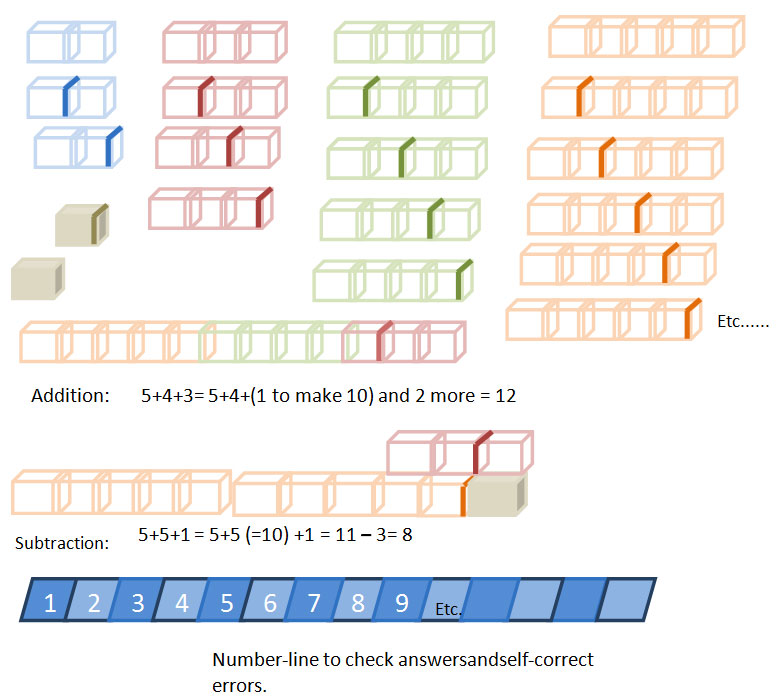The teaching benefits offered by multi-sensory didactic materials can be helpful to a wide age range, and a broad spectrum of ability and interest.
When multisensory materials are carefully designed they can intrinsically meet different styles of learning, different levels of skill, and sensory perceptual differences. The quality of independent child-directed learning supported by multisensory teaching materials may be influenced by the integration of the following 9 key factors:
- A comprehensive integration of the human sensory spectrum
- Physical movement and associated co-ordinated actions.
- Supporting themes of associated conceptual understanding.
- Incorporated strategies that help attention, reception and recall (memory skills and strategies).
- A focus on personal motivation and participation.
- Activity that promote meaningful challenges of enquiry, exploration and discovery.
- A format that promotes a correct initial learning experience.
- Intrinsic opportunities for correction of error.
- Expansion into further associated creative activity and future intellectual development.
If multisensory materials meet the points listed above then the learner may gain a holistic experience that can be adapted to meet the individual needs and preferred style of learning. Scaffolding can meet the learner with a broad multisensory presentation and subsequently adult facilitation may be free from personal sensory strengths, learning preferences and interests. Thus, the learner can be less dependent upon adult support and the confinement of learning from another person’s perspective.
The quality of independent child-directed learning supported by multisensory teaching materials may be influenced by factors presented in the list presented 1-9 above. Failure to meet all the aspects described in the list could change the learning materials from helpful to confusing. Thus multi-sensory experience is not in itself going to improve the quality of learning. The quality of learning is directed by how the design meets all sensory and conceptual information as related to initial foundation learning and future extended learning. The above list presents nine key areas of consideration that need to be considered carefully when designing multi-sensory materials.
An important aspect of multi-sensory learning is facilitated by an initial period of free exploration of the materials. This opportunity for free play should also allow the explorer to engage in creative expression, social interaction, and physical skills. After an initial period of free exploration has been voluntarily completed, the explorer can be encouraged to begin a focused journey of activity towards an acknowledged conclusion.
Using colour to indicate information
In the Eastwood Education colour coded alphabet the colour of the letter indicates its phonic representation in the word. For example the grey letters are those that are present in words where they are silent and do not indicate any spoken (phonic) sound:-

Multi-sensory learning materials can offer a broad and solid foundation for learning that may be especially supportive to additional areas of associated learning. Similarly well designed multi-sensory learning materials can also facilitate future expansion into further areas of new learning.
Problems found in unstructured multi-sensory and imaginative presentation
Unstructured multi-sensory or imaginative presentation can be very confusing. The level of potential for confusion and adverse learning experience is shown in the illustrations below taken from a children’s alphabet book: ‘ALPHABATICS’ by S. MacDonald. This book creatively presents acrobatic letter movements of up to 360 degrees rotation. The picture below shows the capital letter A turned upside down to form the picture and associated visual perceptual skills. The resulting picture then relates to the initial sound of ‘ar’ for ark rather than an initial vowel sound of the short vowel ‘a’ as in apple or the long vowel ‘a’ as in apron.
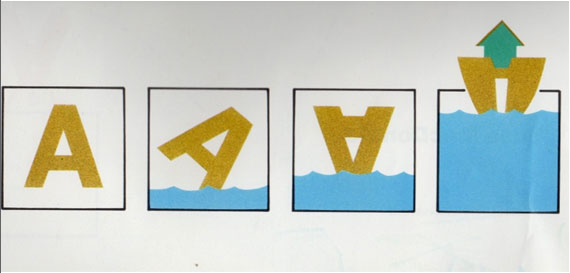
The G has turned 90 degrees and then the perceptual skill is one of focusing on the enclosed yellow space instead of red letter G. Finally the initial letter sound is J rather than G.
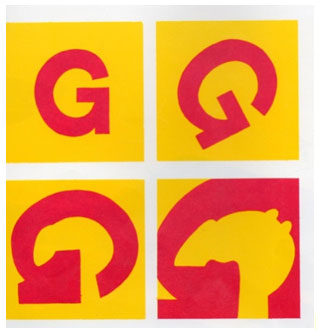
Here the lower case script is chosen rather than the capital and then it is turned upside down to produce the associated picture.
Even more interestingly !When this book reaches the letter ‘n’ the letter is turned upside in to a ‘u’ to create a picture of a nest and then the opposite happens when the ‘u’ is turned upside down into an umbrella.
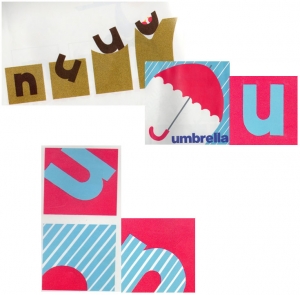
In contrast the same book addressed the letter ‘S’ as a swimming swan which works very well unless the orietationalactobatics presented in the book encourage a child to fail to address the conventional left – right direction and the letter s is drawn swimming in a right to left direction.
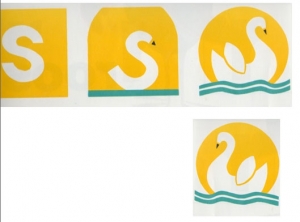
This book presents very interesting and adventurous visual pictorial presentations that may provide interesting challenges to those that are competent with printed text, but to those who are at the initial learning stages this book could create future areas of confusion and lack of conceptual understanding. The early learner may not take on the importance of letter orientation when learning to read and write and be susceptible to reversals and other reading and spelling problems.
Successfully meeting a wide age range and a broad spectrum of ability and interest
The teaching benefits offered by multi-sensory didactic materials can be helpful to a wide age range, a broad spectrum of ability and interest. When multisensory materials are carefully designed they can intrinsically meet different styles of learning, different skill levels and a wide spectrum of sensory perceptual differences.
A wooden time teaching clock
The following example is a multi-sensory design for a wooden time teaching clock:-
A wooden clock supplied with different sets of 12 removable wooden disks: i.e. 1,2,3,…12; 1/13, 2/14, 3/15….12/24; written numbers – one, two etc…. Roman numerals – I to XII; dots indicating numerical value (1-12) organised in paired patterns for easy recognition.

A large wooden cog system of movement could be a 12 cog gearing that correlated one cog for each five minute movement of the hour hand. The minutes could be illustrated with dots around the outside of the clock with a different coloured or shaped dot on the five minute intervals.[The design illustration below does not present the ideal proportional overall structure.]
A see through ring at the end of an appropriate length hour hand not only clearly indicates the hour time but also gives a sense of where the hour hand is as it travels from one o’clock time on to the next. The numbers appearing and disappearing as the hand moves around the clock adds interest and further sense of movement.
The wooden clock above offers all the teaching aspects presented on a traditional teaching clock; without the complexity of presenting all the information at the same time and with the added dimension of interactive participation and kinaesthetic sensory experience.
The teacher and/or pupil can address the learning experiences in simple step by step stages whereby one aspect of learning is organised in association with previous learning and experience. Answer charts similar to the clock face should be available for self-correction, as illustrated below.
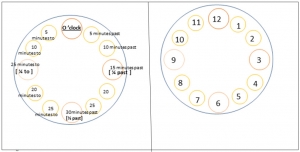
A more holistic learning experience
When learning materials meet the nine key points listed above then the learner can gain a more holistic learning experience that they can adapt to meet their individual needs and preferred style of learning. Successful multi-sensory learning experiences also make the learner less distracted by the personal sensory strengths, learning style and interests of others. Facilitators may also feel more confidence in their ability to creatively meet the learner’s preferred style of learning.
Games based on a specialised multi-sensory set of balls
The following game designed by the author is an example of how the above can be related to a specific activity.
Each ball has been chosen for its outstanding sensory qualities and together they provide a wide range of tactile and multisensory experience including those less notable senses that differentiate the balls through smell, weight or density.
Before engaging in the game described below the author would normally prepare players with an open opportunity to explore through free play with the tactile set of balls shown in the following picture.
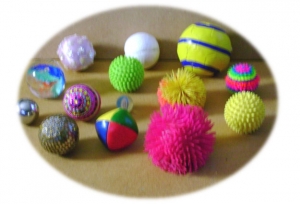
The free play gives the participants an opportunity to explore the kinaesthetic and visual qualities of each ball. Often the free play session becomes a spontaneous game of throw and catch. This increases the sensory experience by adding: co-ordination skills, fast moving balls, motivation to successfully catch (even when a ball is thrown unexpectedly from an obscure direction) and motivation to accurately throw the different shapes and weights so that they can be successfully caught.
After a session of free play the same group of players would be invited to play the conventional Kim’s game with the same set of balls as shown.In the Kim’s memory game one person secretly removes one of the balls and the other players have to identify and describe which ball has been removed.
Finally the balls could be used for a third and more advanced game.
This third game gives kinaesthetic and visual memory practice as well as encouragement to practise and develop vocabulary and expressive language skills.
To begin this third level of the game all the balls are placed on a tray in front of the players. [Optional introduction: Then the balls are passed around to all the players one at a time and each player holds each ball for a chosen length of time before passing it on to the next player.]
Description of third game:-
[Option: The number of different balls presented at the beginning of the game can be altered to meet different levels of ability, and increase when the participants have become familiar with a particular collection of balls.]
When everyone has become familiar with the balls in the game, the balls are taken away out of sight to a place where one player secretly puts one ball in a box and takes it to a seat facing the other players. This person can look in the box whenever s/he wishes while answering ‘Yes, No’ questions from the other participants who are trying to identify the chosen ball which is now hidden in the box. The players now ask questions to discover which ball is hidden in the box. If a question does not have a clearly correct yes of no answer the answer to the question should be ‘pass’. The ‘pass answer invites the players to rephrased or reconstruct the question and present it in the hope of getting a clear yes of no answer.
Another version of this game is possible when there is a set of photos to match the balls on the tray. Then player who chooses a ball can select a picture of their chosen ball and place the picture in the box. The picture can be refer to during the question timewhile the players still have all the balls in front of them.
More challenging versions of the games described above can be facilitated by sets of objects that present a similar concept or definition.E.g. the author had used: a collection of: similar coloured natural stones; crystal geometric shapes; different types of fir cones; and a collection of different grasses. [Some of the free play sessions may need to be restricted to each individual carefully holding one object at a time in their hand for a while.]
Further games can be played using two identical sets of picture cards. For example the author used identical pictures of vegetables from identical seed catalogues to make two sets of matching cards for the game ‘Guess My Vegetable’. When cards are used, one set is placed on the table and the other set is given to the person who secretly chooses one picture card and places it in his/her secret box. The game then continues as before until the other players have asked enough questions to discover which copy of the pictures on the table is hidden in the box.
Those asking the questions can turn over any cards that their questions appear to have eliminated as a possible match for the card hidden in the box. The game can be made very much more difficult when the questions cannot include words that define numbers or colours. The author has created sets of cards to facilitate different Guess My Card themes, such as: On the Sea Shore; Wild Animals; People’s Faces; Vegetables; Flags; Water Birds; Flowers and an extensive and popular set of Drawn Cartoon Dogs. When matching flags the colours do matter and more importantly the colours must be presented in the correct sequence. Therefore, when playing the Guess My Flag game colours are usually allowed because many flags have the same colours on them even though the design is different. The top right hand corner of these cards is rounded or a line is drawn to indicate a flag pole on the left hand side of the flag. This helps the players to place the flag pictures in their correct orientation and confusion due to miss matched orientation can be avoided.
Note : The elements of self-discovery in the ‘Guess What‘s on My Card’ game are very strong because the game is valid even when the questions and answers are not as accurate or as helpful as they might be! Some questions may need to be represented or rephrased in order to discover possible misleading questions and inaccurate answers.
A Rhyming Word Reading Activity
Materials – a set of picture cards that represent rhyming pairs of words e.g.
Cat-hat; mat – bat; sheet – feet; tree – three; bin – tin; red – bed; sock – clock.
- These rhyming pictures are in two sets and the introduction to the materials could be to match sort the pictures into rhyming pairs ( using one picture form each set 1 and one from set 2 to make each rhyming pair. If the learner does not identify a picture correctly the facilitator can encouraged that the picture is given another name. For example if the learner calls the mug a cup. The facilitator could then say ‘Yes it could be called a cup but in this game that picture is not called a cup; can you think of another easy word to describe this picture? Other questions can also be used to give clues as to the word that this picture represents e.g. ‘What type of cup is it?’ Or ‘If someone wanted a large cup of coffee they might want to use a ……….?’
- Then just the first set of pictures (one of each set of the 7 rhyming picture pairs are placed on a table as shown.
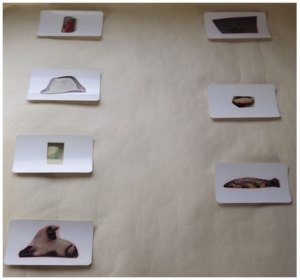
- Then appropriate word cards are placed under each picture. This game gives the option to use initial letter sounds as a clue to finding the word card that matches each of the first set of pictures. The initial letters or the whole word can also be presented on the reverse of each picture card to provide (if required) a systems of self-correction.

- Then the second set of rhyming pictures are also appropriately placed on the table.
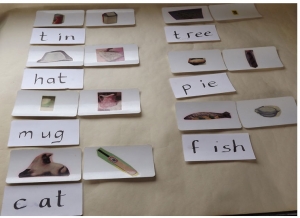
-
- Now a set of letter cards are presented one for each of the second rhyming pictures. The initial letter/s can also be presented on the reverse of each picture which can also help the player to identify the correct rhyming name for the picture.Using the initial sound of each picture card the learner now places the correct letter card under each of the rhyming pictures.
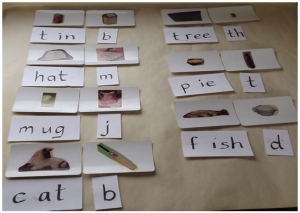
- Now a set of letter cards are presented one for each of the second rhyming pictures. The initial letter/s can also be presented on the reverse of each picture which can also help the player to identify the correct rhyming name for the picture.Using the initial sound of each picture card the learner now places the correct letter card under each of the rhyming pictures.
Now the player picks up the initial letter and places it on top of the first word to make it say the rhyming word and then moves the word card under the rhyming picture.The initial word tinbecomesbin. hat becomes mat; mug becomes jug etc
A summary of the multisensory aspects incorporated within this game is presented as follows:-
- Accurate recognition of artistic visual pictures representing real objects.
- Auditory identification of visual pictures and rhyming words.
- Kinaesthetic movements and auditory reception associated with pronunciation of rhyming words
- Search for specific vocabulary related to rhyming words, i.e. Mug not cup, to match rug not carpet.
- Identification of initial letter sounds and their respective letter shapes.
- Specified and logical strategies related to moving the cards into rhyming pairs and subsequent word building.
- Visual picture and word matching needed for control of error using the answer cards.
Within this game the participant is challenged to meaningfully integrate discovery as an aid to: utilisation of different areas of brain activity; coordination of fine motor control; identification of rhyming sounds; correct spelling for the rhyming words; memory and recall of spellings.
Form drawing activities as an experiences of symmetry and rotation
From class one (6-7year olds) Steiner introduces children to 2D orientation through a progressive gradation of form drawing activities. The kinaesthetic experiences of symmetry and rotation and the visual perceptual skills associated with these lessons can be supportive to the children’s own free drawing and design and possibly create a foundation of awareness that may support their discernment of letter orientation.
Drawing patterns/design


- Five lines make this five pointed star. It can be drawn as one consecutive movement. A real celebration of five with the five points the five triangles and the five-sided shape in the middle to be discovered as the skill of production develops rather than shown by another already knowing

Supporting future levels to learning
A further issue to consider within multisensory materials is whether the discovery learning is appropriate and helpfully supportive to future levels to learning and ability without imposing areas of unlearning.
The author has created an alternative set of number rods for addition and subtraction operations.
Number rods for addition and subtraction
These rods develop the concept that all number operations relate to number bonds to ten: 1+9=10; 2+8=10; 3+7=10; 4+6=10; 5+5=10. Although these rods relate to making units into tens; the conceptual principle is just as valid when working with tens, hundreds, thousands etc. and the associated learning related to place value and our base ten system.
